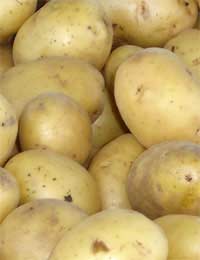
Growing your own potatoes will save you a lot of money. A net of 20 tubers, producing an average of 1kg per tuber, works out at 20p/kilo of produce. The only problem, for those with small gardens or limited shed room, is storing the crop. So what’s the best way to manage your potato harvest?
Storing and Freezing Potatoes
The best potatoes for storage are the ‘maincrop’ varieties – these typically have higher yields and a longer growing period than first or second earlies. Plan to grow some of each, but plant only enough earlies for immediate consumption (a net of 20 tubers will give you a 2-3 month eating period).Your main potato crop will benefit from a long growing season. Plant the seed potatoes in April and leave them until the first frosts – checking occasionally from late summer to make sure they aren’t being attacked by eelworm or slugs. Provided they’re not struck with blight or munched underground, your potatoes will continue to grow and multiply until autumn.
Choose a dry day to lift the potatoes, using a fork to lift them out and lay them on the soil to dry in the sunshine. Brush gently to remove excess soil. Now they are ready for storage. Put any that are bruised, damaged or very small aside – these should be eaten sooner rather than later. Choose the best, largest tubers for storing and be careful not to bruise during packing. You have a few options:
Storing Potatoes in the Shed
A cool, dark shed is an appropriate place to keep potatoes: put them gently into potato sacks or paper bags. The ideal site is a stone outhouse or back porch – somewhere that you can be fairly sure that the temperature will not rise or fall too much. Potatoes will sprout if it’s too warm, and rot if it drops below freezing. An unused chest freezer makes the perfect place to store potatoes – layer them with clean straw and leave the lid open a crack to let air circulate.
Storing Potatoes in a Clamp
This old-fashioned method also depends on a carefully-chosen site, and it will not protect the potatoes entirely from frost – but it’s equally suitable as shed storage, and ideal if you don’t have a handy outbuilding.
Choose a dry day and mark out an area of ground that’s about a metre squared. Use clean, dry straw to make a thick layer on the square. Let your potatoes dry very thoroughly before laying them onto the straw, building up in decreasing layers until you have a knee-height, pyramid-shaped pile of potatoes. Now completely cover the pyramid with another thick layer of clean straw. At this point, let the pile rest in the sunshine to dry out any damp. Finally, use a shovel to heap soil onto the pile, making an outer layer that’s about 15cm deep. Let some of the straw peep out – this lets air in to circulate. The potatoes will keep well through the season in the clamp, unless very hard frost is forecast (in which case, you should retrieve the potatoes and eat as soon as possible).
Freezing Potatoes
Provided they’re cooked first, potatoes can also be successfully frozen – see our article, How to Freeze Vegetables, in the left panel.
